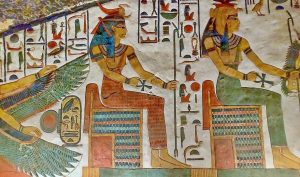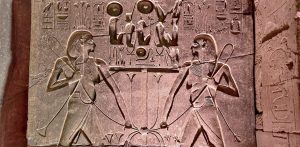On the walls of their temples and tombs, the ancient Egyptians documented every aspect of their lives. According to the ancient Egyptians, life is split into two parts: the first life, which is limited, and the afterlife, which is limitless. We discovered that the majority of scenes and details from the first life are in non-royal tombs, but the majority of scenes from the afterlife are in the king’s tombs. On the walls of the temples, mixed scenes are portrayed.
What is the Book of the Dead?
The Book of the Dead is a genuine book with text and images, split into chapters and beginning with an introduction! This book, on the other hand, is not written on paper and does not assume the current form of a book that we can carry about and save in our libraries. The Book of the Dead is inscribed within the graves of ancient Egyptian rulers, and it discusses and offers specifics about how those monarchs pass to the hereafter, as well as religiously describing these afterlife qualities.

“Ta-Magt Umm Duat,” or “the book of what is in the other world,” or “um-dwat” or “Imy-dwat,” is the complete ancient Egyptian name for the book. “The Text of the Hidden Chamber in which the Spirits of Gods and Good Shadows Stand,” also known as “The Text of What is in the Other World” or “The Book of What is (Being) in the Other World,” is an ancient Egyptian religious book. It has been inscribed on the walls of royal tombs as one of the most important religious texts from the beginning of the eighteenth dynasty, and it was the only adornment of the burial chambers.
The Book of the Dead in the Kings’ Valley
The book of the dead’s earliest versions Royal religious manuscripts were discovered within the pyramids of the 5th and 6th dynasties in the ancient kingdom. This ancient literature, known as “the Pyramids text,” is thought to be the oldest form of the Book of the Dead, including religious and royal characteristics. The Pyramid text vanished in the middle kingdom, but reappeared in the new kingdom in the graves of important officials at the same time as a refined form of the Book of the Dead was discovered in the Royal tombs. Since the beginning of the eighteenth dynasty, the book of the dead has been one of the most significant religious texts written on the walls of royal tombs.
Although the earliest stages of this book were traced back far earlier than the Luxor era, it first appeared in the Valley of the Kings in the tombs of King “Thutmose the First” and Queen “Hatshepsut” (KV 20). The book may also be found in the tombs of vizier “Waser Amun” and “Amenhotep the Second,” where we can view the complete book in order, as well as a truncated version at the conclusion. The first hour of the book of hours (a chapter from the book of the dead) was written in “Tutankhamun’s” tomb, while sections of two hours were carved into one of King Tut’s golden chapels. The book was discovered in the burial chamber of King Seti I’s tomb, and it is also there inside the tombs of Ramses III, Ramses IV, and Ramses V. The book continued to be recorded in the vestibules of the tombs and was only for the Kings, as it did not appear in any individual tomb during the eighteenth dynasty, except for the tomb of the minister “Waser Amun” from the reign of Thutmose III, who had a special status with the king, allowing him to record the book in his tomb. The book remained a royal book until the Twentieth Dynasty when the priests of Amon arrived in Thebes to reign, and they seized this right (Like Royals) and recorded parts of the book in their graves or on their coffins.
What do the portals to other world show?

The landscape in the other world is distorted from what you’re accustomed to seeing on Earth. Everything in this universe is larger than it seems, and its dimensions are determined by holy standards that are much greater than royal human standards. It’s worth remembering that time has distinct dimensions in the other world. One hour is the equivalent of a lifetime on Earth for night travel. In this world, everything is backwards. In actuality, the sun returns to its original position. All creatures, including humans, are moving backward in the massive serpent that reborn from tail to mouth on the eastern horizon, causing them to transform from adults to children, and even ancient funeral texts show that people in that world are forced to walk on their heads or eat their own excrement to the side. The digestive system is also flipped upside down. Texts and photographs in the world of the dead often refer to inverted or reversed water. In some places, we find complete paragraphs of reversed text, hinting that the Other World must be read backward, in addition to the usual inclination of hieroglyphic writing. The portals to another realm The ancient Egyptians associated death with natural events, particularly since the sun’s cycle resembled life after death.
The Book of the Hours

When the sun rises, life begins, and when the sun sets, death begins. The sun had three instances in the other world, all of which were tied to the names of the sun gods. “Khebri” means “sunrise,” while “Ra’a” means “noon.” “Atom,” says, the sunset. The cycle of the sun throughout the twelve hours of the night is described in the Book of the Dead. It’s broken down into 12 sections. Each section corresponds to a different hour of the night. The sun’s cycle begins in the other world in the god Ra’s boat by crossing the gates, and each gate has a deity; the deceased must know all of these deities and answer their questions, as well as all of the forms and texts because the deceased encounters various obstacles along the way and must overcome them all.
- In the first hour, the deity “Ra’s” boat, the so-called “sister” that travels between day and night, approaches the western horizon.
- The boat traverses a huge sea in the second and third hours.
- The fourth hour: the boat arrives at a sandy beach and encounters the deity Soker, the underworld falcon.
- The fifth hour: the boat arrives to “Osiris’ tomb, where a lake of fire has been lighted underneath it, and a pyramid has been built above the cemetery, depicting the two gods “Isis and Nephthys” as two kites.
- The sixth hour is regarded the most significant since it is here that the deity Ra’s “ba” soul reunites with his body in a serpent-formed circle, and the sun re-emerges.
- The deceased’s boat is welcomed by a wild serpent called “Apophis” during the seventh hour.
- The cemetery entrance opens at the eighth hour.
- The deceased leaves the sandy shore (described in the fourth hour), and he returns to the ocean at the ninth hour.
- The tenth and eleventh hours: In the water, the recuperation process continues.
- The twelveth hour: God’s eye regains its eyesight (a sign of his health and safety, as well as the return of his birth), and he reaches the eastern horizon in readiness for sunrise and the start of a new day.
The book was written on papyrus during the Middle Kingdom era, and it was discovered in the tombs of high officials. Until at least Dynasty 30, parts of the book of the dead were discovered inscribed on the exterior and interior of coffins and sarcophagi. While it was totally recorded in the royal tombs during Dynasty 18, just a few hours were written in the dynasties that followed.
It’s a terrific sensation to be able to go about Saqqara’s ancient site to see the Pyramid text, and Luxor’s old city as part of one of our Egypt Tour Packages and experience the beauty and still-vibrant hues of the Book of the Dead in the Valley of the Kings.






